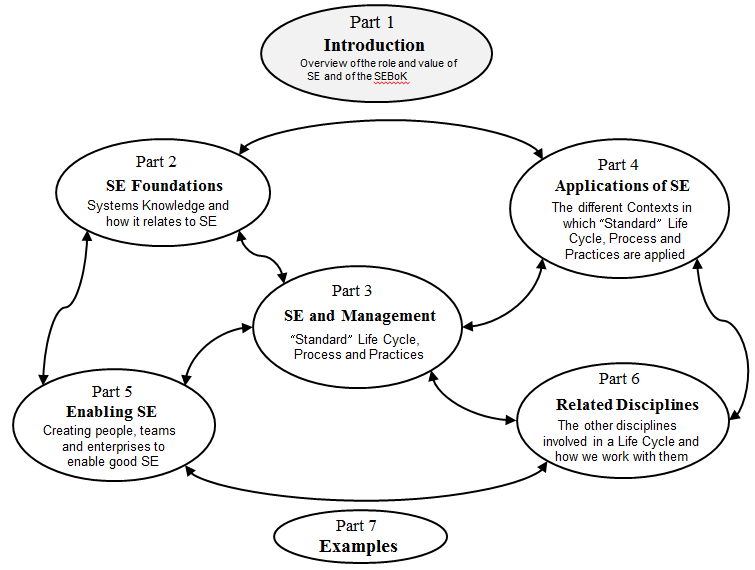Difference between revisions of "SEBoK Introduction"
m (Text replacement - "<center>'''SEBoK v. 1.9.1, released 16 October 2018'''</center>" to "<center>'''SEBoK v. 2.0, released 1 June 2019'''</center>") |
|||
| Line 28: | Line 28: | ||
[[Category:Part]][[Category:Part 1]] | [[Category:Part]][[Category:Part 1]] | ||
| − | <center>'''SEBoK v. | + | <center>'''SEBoK v. 2.0, released 1 June 2019'''</center> |
Revision as of 21:18, 2 June 2019
The purpose of the Guide to the Systems Engineering Body of Knowledge (SEBoK) is to provide a widely accepted, community-based, and regularly updated baseline of systems engineering (SE) knowledge. SEBoK Part 1 contains an introduction to both the discipline of SE and an introduction to the SEBoK wiki and how to use it.

Part 1 also includes an introduction to some of the emerging aspects of systems engineering and a discussion of how these are transforming the discipline. As this knowledge matures it will be migrated into the main body of the SEBoK.
Part 1 Knowledge Areas
Each part of the SEBoK is divided into knowledge areas (KAs), which are groupings of information with a related theme. Part 1 contains the following KAs:
- Introduction to the SEBoK
- Introduction to Systems Engineering
- Introduction to SE Transformation
- SEBoK Users and Uses
Scope and Context of the SEBoK
The SEBoK is one of two complementary products. The other, which uses the content of the SEBoK to define a core body of knowledge (CorBoK) to be included in graduate SE curricula, is called the Graduate Reference Curriculum for Systems Engineering (GRCSE™). GRCSE is not a standard, but a reference curriculum to be tailored and extended to meet the objectives of each university's graduate program. (Pyster and Olwell et al. 2015) These products are being developed by the Body of Knowledge and Curriculum to Advance Systems Engineering (BKCASE) project.
Most of the SEBoK (Parts 2 – 6) focuses on domain-independent information—that which is universal to systems engineering regardless of the domain in which it is applied. Part 7 includes examples from real projects. These illustrate the concepts discussed elsewhere in the SEBoK, while detailing considerations relevant to domains such as aerospace, medicine, and transportation.
SE in the context of engineered systems (ES) is the primary scope for the SEBoK, though general systems concepts are also discussed in Part 2. The SEBoK also covers considerations for the disciplines of software engineering and project management, which are strongly intertwined with the practice of SE (see Part 6).
References
Works Cited
Pyster, A., D.H. Olwell, T.L.J. Ferris, N. Hutchison, S. Enck, J.F. Anthony, D. Henry, and A. Squires (eds). 2015.Graduate Reference Curriculum for Systems Engineering (GRCSE),version 1.1. Hoboken, NJ, USA: The Trustees of the Stevens Institute of Technology ©2015. Accessed on 4 December 2015 at BKCASE.orghttp://www.bkcase.org/grcse-2/.
Primary References
Pyster, A., D.H. Olwell, T.L.J. Ferris, N. Hutchison, S. Enck, J.F. Anthony, D. Henry, and A. Squires (eds). 2015.Graduate Reference Curriculum for Systems Engineering (GRCSE™), version 1.1. Hoboken, NJ, USA: The Trustees of the Stevens Institute of Technology ©2015. Accessed on 4 December 2015 at BKCASE.orghttp://www.bkcase.org/grcse-2/.